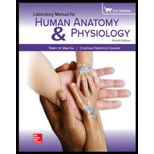
Compare the relative lengths and paths of the uterine tubes (oviducts) of the fetal pig and the human.
To write:
The difference between the comparative lengths and paths of the oviducts or uterine tubes of the fetal pig and human.
Introduction:
Anatomy can be defined as a branch of biology that is associated with the study of the organism’s structure and its parts. In anatomy, the superficial indicates the structure is closer to the surface of the body or presents more outside than another.
Explanation of Solution
Uterus:
It is an organ located in the lower body of a female mammal or woman. In this region, the offspring is conceived. It is known as a womb in which the fetus is gestating before birth.
The difference between the comparative lengths and paths of the oviducts or uterine tubes of the fetal pig and human:
| Difference criteria | Uterus of pig(uterine tubes) | Uterus of human female(uterine tubes) |
| 1. Shape | 1. The pig’s uterus is Y-shaped. It has branches that form the left and right uterine horns. | The human uterus has a single chamber. The offspring develops in this region. Humans lack the branches or uterine horns. |
| 2. Uterine tubes | These are small and coiled tubes located near the ovaries. They travel a small distance to meet the uterine horns. | These are larger and longer. They pass to the uterine body from the ovaries. They have a relatively long distance from the uterus. |
Uterine tubes are small and coiled tubes in fetal pigs than in humans.
Want to see more full solutions like this?
Chapter 68 Solutions
Laboratory Manual for Human Anatomy & Physiology (Cat Version)
- Identify the indicated cavity (Fucus). a. antheridia b. conceptacel c. receptacle d. oogonium e. none of thesearrow_forwardIdentify the indicated structure (Saprolegnia). a. antheridium O b. oospore c.sperm d. auxospore e. tetraspore Of. zygosporearrow_forwardUsing information from the primary literature (several references have been provided as a starting point below) please answer the following question: Based on your review of the literature on rewilding, what are the major scientific pros and cons for rewilding? Please note that the focus of this assignment are the (biological) scientific issues associated with rewilding. As will be discussed in class, there are a number of non-scientific issues involved or implicated in rewilding, all ultimately affecting the public acceptability of rewilding. Although these issues are important – indeed, critical – in this assignment you should focus on the biological science issues and questions. Details: You must enumerate at least two pros and at least two cons. Your answer should be no more than 500 well-chosen words, excluding references. Think carefully about how best to organize and structure your answer. Aim for high information density: say a lot, but say it succinctly. Recall Nietzche’s…arrow_forward
- Using information from the primary literature (several references have been provided as a starting point below) please answer the following question: Based on your review of the literature on rewilding, what are the major scientific pros and cons for rewilding? Please note that the focus of this assignment are the (biological) scientific issues associated with rewilding. As will be discussed in class, there are a number of non-scientific issues involved or implicated in rewilding, all ultimately affecting the public acceptability of rewilding. Although these issues are important – indeed, critical – in this assignment you should focus on the biological science issues and questions. Details: You must enumerate at least two pros and at least two cons. Your answer should be no more than 500 well-chosen words, excluding references. Think carefully about how best to organize and structure your answer. Aim for high information density: say a lot, but say it succinctly. Recall Nietzche’s…arrow_forwardNow draw a rough sketch of what the control data might look like if in addition to the specific binding, there was also a considerable amount of nonspecific binding (again using a normal dose/response curve) (do % total bound ligand vs concentration)arrow_forwardWhat are functions of cuboidal cells in the kidney? Select all that apply. Concentration of gases Dilution of chemicals Secretion of molecules Nutrition to tissues Support of tissues Absorption of moleculesarrow_forward
- question1 In plants, epithelial tissue is only found as the outermost cell layer and acts as a barrier. In humans, epithelial tissue is found inside the body as well as on the surface. What function(s) does/do epithelial tissue carry out in humans? Select all that apply. Waste storage Filtration Oxygen transport Protection Diffusion Osmosis Absorptionarrow_forwardWhat words best describes this organism? a. Unicellular/nonmotile Ob. unicellular/motile c. colonial/nonmotile d. colonial/motile e. multicelluar O f. siphonous g. none of thesearrow_forwardIdentify the phylum or class. a. Euglenophyta b. Dinoflagellata c. Bacillariophyceae d. Oomycetes e. Phaeophyceae O f. Myxomycota g. Xanthophyceae ○ h. Chrysophyceae i. Dictyosteliomycota O j. Rhodophyta Ok. Chlorophyceaens I. Charophyceaensarrow_forward
 Human Biology (MindTap Course List)BiologyISBN:9781305112100Author:Cecie Starr, Beverly McMillanPublisher:Cengage Learning
Human Biology (MindTap Course List)BiologyISBN:9781305112100Author:Cecie Starr, Beverly McMillanPublisher:Cengage Learning Biology (MindTap Course List)BiologyISBN:9781337392938Author:Eldra Solomon, Charles Martin, Diana W. Martin, Linda R. BergPublisher:Cengage Learning
Biology (MindTap Course List)BiologyISBN:9781337392938Author:Eldra Solomon, Charles Martin, Diana W. Martin, Linda R. BergPublisher:Cengage Learning Human Heredity: Principles and Issues (MindTap Co...BiologyISBN:9781305251052Author:Michael CummingsPublisher:Cengage Learning
Human Heredity: Principles and Issues (MindTap Co...BiologyISBN:9781305251052Author:Michael CummingsPublisher:Cengage Learning Human Physiology: From Cells to Systems (MindTap ...BiologyISBN:9781285866932Author:Lauralee SherwoodPublisher:Cengage Learning
Human Physiology: From Cells to Systems (MindTap ...BiologyISBN:9781285866932Author:Lauralee SherwoodPublisher:Cengage Learning





